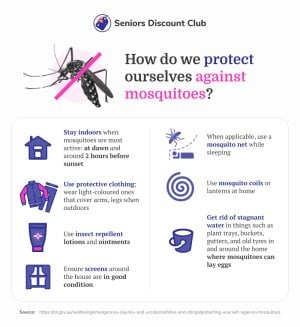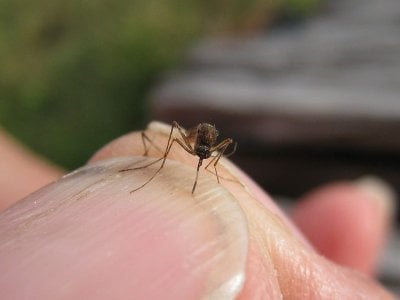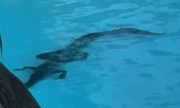Take care! 70-year-old dies after getting infected by rare mosquito-borne disease
- Replies 7
We hope you’re putting extra effort into staying safe and keeping an eye out for potential health risks in your area, especially during mosquito season!
As you already know, mosquito bites can cause all sorts of rashes and nasty side effects but recent reports are providing much cause for concern.
A case of a potentially deadly illness has been detected by local authorities in NT, prompting an urgent health alert.
In January, a woman in her 70s died from Murray Valley Encephalitis. It is believed she ‘most likely’ contracted the disease in Darwin.
The case is the third recorded in NT in the last five years, according to reports.
This development comes just days after SA health officials announced the detection of another case in Clare, which caused concern as it is reportedly the first instance of the disease outside of communities along the Murray River.
What is Murray Valley Encephalitis?
The rare disease is caused by the Murray Valley Encephalitis Virus (MVEV), known to be present in Northern Australia and Papua New Guinea.
The most common carrier of the disease is the common banded mosquito Culex annulirostris, which has light brown colouring and distinct bands along its body.
The mosquito is said to be active all year round but is especially active in October and May.
Getting bitten by a mosquito carrying MVEV isn’t bad news per se as cases are ‘often asymptomatic’.
In the rare cases where symptoms manifest, those with the disease can have fevers, headaches, nausea, vomiting, and tiredness.
More concerning cases of Murray Valley Encephalitis have reported severe headaches, sensitivity to bright light, seizures and fits, drowsiness, loss of consciousness, neck stiffness and confusion.
Encephalitis refers to swelling of the brain. Severe cases of the disease may lead to long-term brain damage or death.
There is currently no known cure for Murray Valley Encephalitis, though one study says a vaccine for Japanese Encephalitis offers cross-protection ‘against lethal challenge’ for the illness.
Aside from the NT and SA, Murray Valley Encephalitis has been known to occur in VIC and NSW.
Since recording began in 1974, there have been 39 cases of the rare disease in Australia. Nine of these ended in death.
Aussies, particularly at-risk age groups like children and seniors, are advised to take necessary precautions against being bitten by mosquitoes to help prevent infection by the MVEV.
Source: YouTube/7News
Similar warnings were issued in March 2022 against Japanese Encephalitis in NSW, VIC, and QLD after the virus-borne disease was detected.

Anyone experiencing any symptoms after getting bitten by mosquitoes, especially those matching Murray Valley Encephalitis, is encouraged to seek medical attention.

Please share this concerning news with friends and loved ones, especially in mosquito-ridden areas so many people can be aware.
In the meantime, you can watch this video posted by NSW Health on Murray Valley Encephalitis.
Stay safe and we wish you the best of health!
Source: YouTube/NSW Health
As you already know, mosquito bites can cause all sorts of rashes and nasty side effects but recent reports are providing much cause for concern.
A case of a potentially deadly illness has been detected by local authorities in NT, prompting an urgent health alert.
In January, a woman in her 70s died from Murray Valley Encephalitis. It is believed she ‘most likely’ contracted the disease in Darwin.
The case is the third recorded in NT in the last five years, according to reports.
This development comes just days after SA health officials announced the detection of another case in Clare, which caused concern as it is reportedly the first instance of the disease outside of communities along the Murray River.
What is Murray Valley Encephalitis?
The rare disease is caused by the Murray Valley Encephalitis Virus (MVEV), known to be present in Northern Australia and Papua New Guinea.
The most common carrier of the disease is the common banded mosquito Culex annulirostris, which has light brown colouring and distinct bands along its body.
The mosquito is said to be active all year round but is especially active in October and May.
Getting bitten by a mosquito carrying MVEV isn’t bad news per se as cases are ‘often asymptomatic’.
In the rare cases where symptoms manifest, those with the disease can have fevers, headaches, nausea, vomiting, and tiredness.
More concerning cases of Murray Valley Encephalitis have reported severe headaches, sensitivity to bright light, seizures and fits, drowsiness, loss of consciousness, neck stiffness and confusion.
Encephalitis refers to swelling of the brain. Severe cases of the disease may lead to long-term brain damage or death.
There is currently no known cure for Murray Valley Encephalitis, though one study says a vaccine for Japanese Encephalitis offers cross-protection ‘against lethal challenge’ for the illness.
Aside from the NT and SA, Murray Valley Encephalitis has been known to occur in VIC and NSW.
Since recording began in 1974, there have been 39 cases of the rare disease in Australia. Nine of these ended in death.
Aussies, particularly at-risk age groups like children and seniors, are advised to take necessary precautions against being bitten by mosquitoes to help prevent infection by the MVEV.
Source: YouTube/7News
Similar warnings were issued in March 2022 against Japanese Encephalitis in NSW, VIC, and QLD after the virus-borne disease was detected.
Key Takeaways
- A potentially deadly mosquito-borne virus called Murray Valley Encephalitis has been detected in the Northern Territory.
- Local health authorities have issued an alert after a woman in her 70s died from the illness in January.
- There is no treatment or vaccine for the disease, which is asymptomatic in most cases.
- There have been a total of 39 Murray Valley Encephalitis cases around Australia since recording began in 1974 and nine deaths.

Wear light and loose clothing that covers your body adequately when outdoors as added protection against mosquitoes. Image Credit: Seniors Discount Club
Please share this concerning news with friends and loved ones, especially in mosquito-ridden areas so many people can be aware.
In the meantime, you can watch this video posted by NSW Health on Murray Valley Encephalitis.
Stay safe and we wish you the best of health!
Source: YouTube/NSW Health
Last edited:








